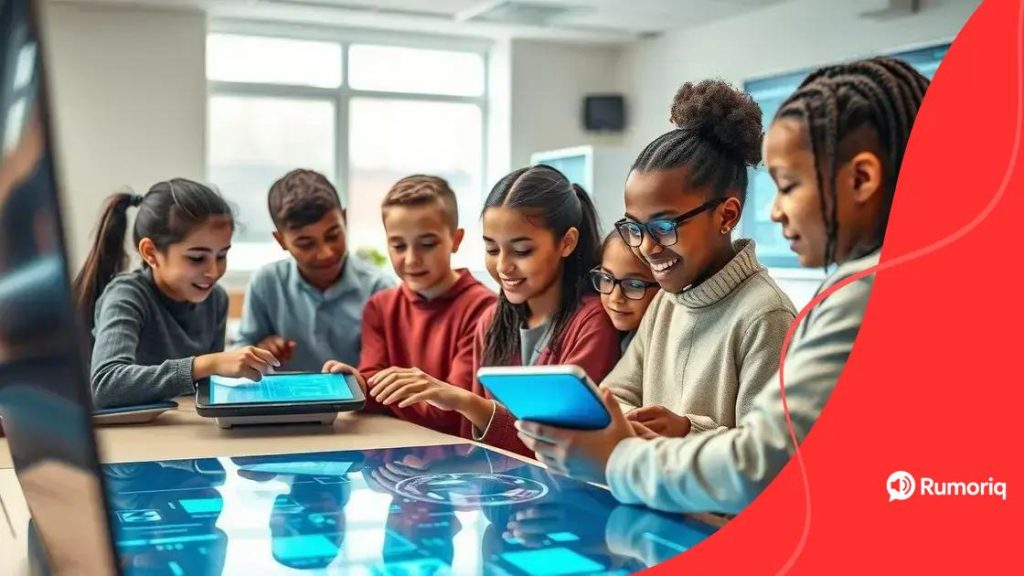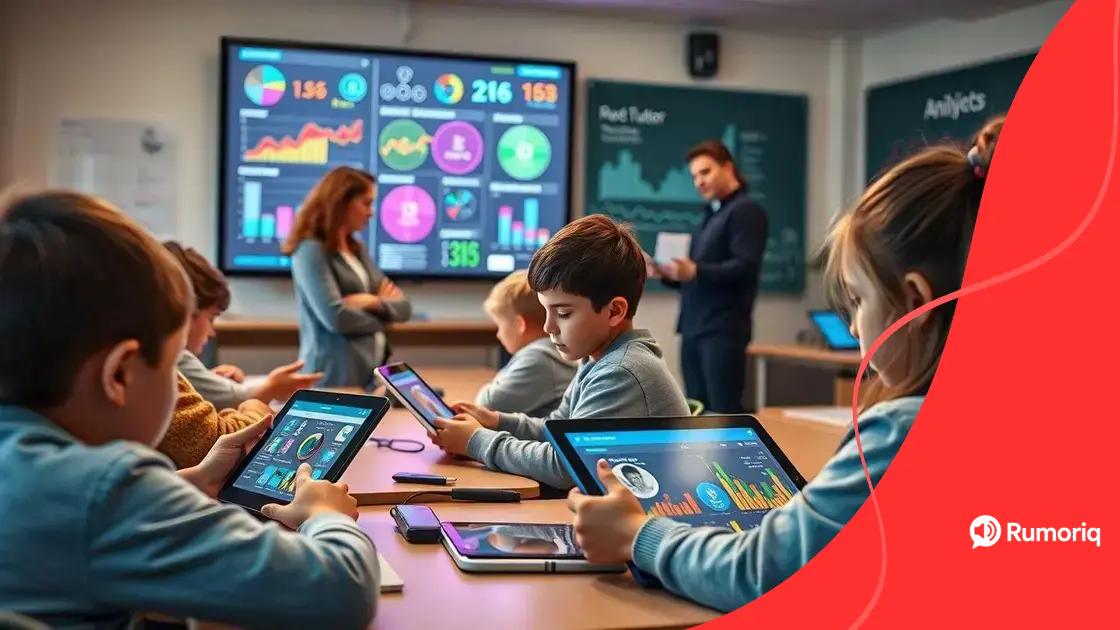AI in the classroom trends: shaping future learning

Anúncios
AI in the classroom trends are reshaping education through personalized learning experiences, enhanced engagement, and improved administrative efficiency, while also presenting challenges like equitable access and ethical considerations.
AI in the classroom trends are changing how educators approach teaching and student engagement. Have you ever thought about the ways technology could personalize your learning experience? Let’s dive into these exciting developments!
Anúncios
Emerging technologies in classroom settings
In today’s classrooms, emerging technologies are transforming how both teachers and students engage with the learning process. From interactive tools to AI-driven educational software, these advancements enhance the learning experience significantly.
Interactive Learning Tools
One of the most exciting trends is the use of interactive learning tools.
- Smartboards make lessons more engaging.
- Online platforms promote collaboration among students.
- Virtual reality immerses students in new environments.
This shift not only makes learning fun but also allows students to absorb information better by actively participating.
Anúncios
Artificial Intelligence in Education
AI technologies are also paving the way for personalized education. These tools analyze student data to identify strengths and weaknesses, enabling tailored learning paths.
For instance, AI-driven tutoring systems provide instant feedback, helping learners grasp concepts at their own pace. Furthermore, educators can use these insights to adjust their teaching methods to fit the needs of each student.
As these technologies integrate into classrooms, the traditional educational structure is evolving. Teachers now act as facilitators, guiding students in using these innovative tools effectively.
However, it’s essential to address the potential challenges as well. Ensuring equitable access to technology can be a hurdle, especially in underfunded schools. It’s crucial to prioritize training for educators to leverage these technologies fully without overwhelming them.
In conclusion, embracing emerging technologies in classroom settings not only enhances learning but also prepares students for a future where digital skills are vital.
Benefits of AI for students and teachers
The use of AI in education is creating remarkable benefits for both students and teachers. These advancements not only improve learning but also enhance teaching methods.
Personalized Learning
One of the biggest benefits of AI is its ability to offer personalized learning experiences. Every student learns differently. With AI, educational platforms can tailor content to fit individual needs.
- Adaptive learning tools adjust to students’ comprehension levels.
- AI provides resources based on students’ strengths and weaknesses.
- Feedback is available instantly, helping students improve quickly.
This personalization fosters a deeper understanding of the material and keeps students engaged.
Support for Educators
Teachers also benefit from AI tools by gaining insights into student performance. These technologies streamline administrative tasks, allowing educators to focus more on teaching.
For instance, AI can help grade assignments efficiently, freeing up valuable time. Moreover, teachers can analyze data trends to identify which areas students struggle with the most, enabling focused teaching strategies.
With the ability to track students’ progress, educators can intervene earlier when help is needed, ensuring no student is left behind.
The combination of AI and human interaction is powerful. While AI provides data and insights, teachers remain vital in guiding students through their learning journeys.
As AI continues to evolve, the education sector will likely experience even more innovative benefits. Students and teachers alike will find new ways to learn and teach effectively, ultimately transforming the educational landscape.
Practical applications of AI in education

AI has numerous practical applications in education that are enhancing both teaching and learning experiences. These applications range from administrative tasks to personalized learning tools.
Smart Tutoring Systems
One prominent application is smart tutoring systems. These AI-driven platforms provide students with extra help outside of the classroom. They adapt to each student’s learning speed and style, offering customized exercises and feedback.
- Students can practice math with interactive problem-solving.
- Literature tools analyze texts, assisting in comprehension.
- Languages can be learned through adaptive quizzes and conversation practice.
This personalized approach enables students to master concepts at their own pace, reducing frustration and increasing motivation.
Administrative Efficiency
AI also plays a significant role in streamlining administrative tasks. Educators often spend considerable time on grading and paperwork. AI can automate these processes, allowing teachers to focus more on instruction.
Automated grading systems can assess assignments quickly and fairly. This technology not only saves time, but also provides immediate feedback to students. Furthermore, AI can help with scheduling by analyzing conflicts and optimizing class times for better resource allocation.
Additionally, data analysis tools use AI to track student performance trends. Educators can analyze this information to identify students who may need additional support. Early intervention can make a big difference in student outcomes.
The integration of AI in education is changing how both teachers and students interact with learning materials. As technology continues to advance, we can expect even more innovative applications to emerge.
Challenges of integrating AI in schools
Integrating AI in schools comes with several challenges that educators and administrators must face. While AI has the potential to revolutionize education, understanding and overcoming these obstacles is crucial for successful implementation.
Equitable Access to Technology
One significant challenge is ensuring equitable access to technology for all students. Not every student has the same access to devices or high-speed internet. This divide can lead to disparities in learning opportunities.
- Students in underfunded areas may lack necessary equipment.
- Internet access is not consistent for everyone.
- This gap can widen the achievement gap.
Addressing this issue requires investment from schools and communities to ensure that every student can benefit from AI-driven learning tools.
Teacher Training and Support
Another challenge is the need for proper training and support for teachers. Many educators may not be familiar with AI technologies or how to integrate them effectively into their teaching strategies.
Professional development opportunities are essential for helping teachers become comfortable with using these tools. This training can ensure that they understand how to leverage AI to enhance student learning rather than hinder it. Moreover, ongoing support from technology experts can help address any questions or concerns teachers might have.
Additionally, concerns about the reliability and accuracy of AI tools can lead to hesitation in adoption. Educators need to feel confident that these systems will work as intended and provide accurate feedback.
As AI continues to evolve, staying informed about best practices and reliable technologies is essential. Collaboration between technology developers and educators can lead to more effective solutions tailored to classroom needs.
Finally, ethical considerations related to data privacy and security also present challenges. Schools must protect student data while using AI tools, requiring strict compliance with regulations such as FERPA.
Future predictions for AI in education
The future of AI in education is full of exciting possibilities that can change how we learn and teach. As technology advances, we can expect transformative effects on education systems worldwide.
Enhanced Personalization
One major prediction is the rise of even more personalized learning experiences. Future AI tools will be capable of analyzing vast amounts of data to adapt not only content but also teaching methods for each student.
- AI will create individualized learning plans based on students’ strengths.
- Real-time adjustments will ensure students receive the help they need, when they need it.
- Feedback mechanisms will evolve, providing deeper insights into student learning patterns.
This level of customization will make learning more relevant and engaging for every student.
Integration of Virtual and Augmented Reality
We can also anticipate the integration of virtual reality (VR) and augmented reality (AR) with AI-powered education tools. These technologies will allow students to explore complex subjects and environments in an immersive way.
For example, history students could take virtual field trips to ancient civilizations, while science students could conduct virtual experiments. This hands-on experience will enhance understanding and retention.
Collaboration between students and AI will become more common. AI can facilitate group projects by forming teams based on complementary skills and interests, enriching the collaborative learning experience.
Data-Driven Decision Making
As AI systems become more sophisticated, schools will rely on data-driven decision making to improve educational outcomes. Educators will use analytics to assess overall classroom performance and identify areas needing improvement.
This will lead to smarter allocation of resources, helping schools address gaps in learning effectively. Moreover, predictive analytics might identify students at risk of falling behind, allowing for early interventions.
With the ongoing development of AI technologies, ethical considerations will also come to the forefront. Discussions around data privacy, bias in algorithms, and the role of educators will shape the policies governing AI in schools.
AI in education is bright and full of potential. We will see enhanced learning experiences that cater to individual needs, making education more engaging for students. Virtual and augmented reality will immerse learners in new ways, while data-driven insights will help educators make informed decisions. However, as we embrace this technology, we must also address challenges related to access, training, and ethics. By staying aware of these factors, we can maximize the benefits of AI in the classroom and create better learning environments for all.
FAQ – Frequently Asked Questions about AI in Education
What are the benefits of AI in the classroom?
AI offers personalized learning experiences, enhances student engagement, and provides teachers with data-driven insights to improve teaching methods.
How can AI help teachers with administrative tasks?
AI can automate grading and scheduling, allowing teachers to focus more on instruction and less on paperwork.
What challenges do schools face while integrating AI?
Challenges include ensuring equitable access to technology, training teachers, and addressing privacy and ethical considerations.
What does the future hold for AI in education?
The future may see more personalized learning, immersive experiences using VR and AR, and improved data analytics for better decision-making.